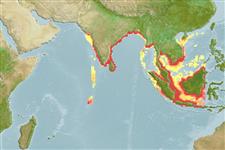>
Clupeiformes (Herrings) >
Engraulidae (Anchovies) > Coiliinae
Etymology: Coilia: Greek, koilia, -as = abdomen, hollow (Ref. 45335).
Eponymy: Jean-Jacques Dussumier (1792–1883) was a French merchant, collector, traveller and ship owner. [...] (Ref. 128868), visit book page.
More on author: Valenciennes.
Environment: milieu / climate zone / depth range / distribution range
البيئة
بحري; المياه العذبة; مياه مخلوطة; مهاجرة بين الياه الملحه و الحلوة لكن ليس للتزاوج (Ref. 51243); نطاق العمق 0 - 50 m (Ref. 189). Tropical; 24°N - 9°S, 70°E - 118°E (Ref. 189)
Indian Ocean: India from Bombay to Calcutta, probably also Myanmar, Thailand and Malaysia. Western Central Pacific: Thailand to Java, presumably also Kalimantan). Valenciennes listed a specimen from Mahé which lies to the south of Cannanore, India but there is no such specimen in Paris.
Length at first maturity / الحجم / وزن / العمر
Maturity: Lm ?, range 1 - ? cm
Max length : 20.0 cm SL ذكر/ مختلط الجنس; (Ref. 9822); common length : 17.0 cm TL ذكر/ مختلط الجنس; (Ref. 9822)
الأشواك الظهرية (المجموع) : 0; شوكة شرجية: 0; أشعه شرجية لينه: 80. Body tapering, belly rounded before pelvic fins, with 5 or 6 (rarely 4) + 7 to 9 = 12 to 15 keeled scutes from just behind pectoral fin base to anus. Maxilla short. Pectoral fin with 6 long filaments and 9 to 11 (rarely 8) branched fin rays. Flanks and belly with golden or pearly spots (light organs) in rows below scales, also along isthmus, edge of lower jaw, on cheek and gill cover.
A coastal and estuarine species, occurring in fully saline water, but also able to tolerate lowered salinities, perhaps almost fresh water. Feeds on copepods, prawn and fish larvae, various unidentified crustaceans and cypris, also stomatopod larvae, mysids, polychaete larvae, isopods and Sagitta. The breeding season is perhaps extended; probably entering estuaries to breed (larvae about 5 km up Burhabalang estuary, Orissa, India in May and June). Utilized as a food fish (Ref. 171).
Breeding season is perhaps extended. Spawn in school (Ref. 205).
Wongratana, T., T.A. Munroe and M. Nizinski, 1999. Order Clupeiformes. Engraulidae. Anchovies. p. 1698-1753. In K.E. Carpenter and V.H. Niem (eds.) FAO species identification guide for fishery purposes. The living marine resources of the WCP. Vol. 3. Batoid fishes, chimaeras and bony fishes part 1 (Elopidae to Linophrynidae). FAO, Rome. (Ref. 9822)
IUCN Red List Status (Ref. 130435: Version 2024-2)
استخدامات بشرية
مصائد: تجاري
أدوات
تقارير خاصة
Download XML
مصادر علي الأنترنت
Estimates based on models
Preferred temperature (Ref.
123201): 27.6 - 29.3, mean 28.7 °C (based on 640 cells).
Phylogenetic diversity index (Ref.
82804): PD
50 = 0.5001 [Uniqueness, from 0.5 = low to 2.0 = high].
Bayesian length-weight: a=0.00355 (0.00193 - 0.00653), b=3.01 (2.85 - 3.17), in cm total length, based on LWR estimates for this species & Genus-body shape (Ref.
93245).
مستوى غذائي (Ref.
69278): 3.3 ±0.39 se; based on food items.
Generation time: 0.9 (0.8 - 1.0) years. Estimated as median ln(3)/K based on 12
growth studies.
المرونه (Ref.
120179): عالي, الحد الزمني الأدني لتضاعف عدد أفراد المجتمع أقل من 15 شهر (tm=0.5-0.6; K=1.07-1.54; Fec=1,000-5,000).
Fishing Vulnerability (Ref.
59153): Low vulnerability (14 of 100).
Nutrients (Ref.
124155): Calcium = 398 [117, 1,022] mg/100g; Iron = 2.56 [0.78, 7.00] mg/100g; Protein = 17.3 [14.5, 20.2] %; Omega3 = 0.306 [0.155, 0.612] g/100g; Selenium = 50.5 [22.8, 113.4] μg/100g; VitaminA = 18.1 [5.4, 46.9] μg/100g; Zinc = 1.62 [0.78, 3.23] mg/100g (wet weight); based on
nutrient studies.
